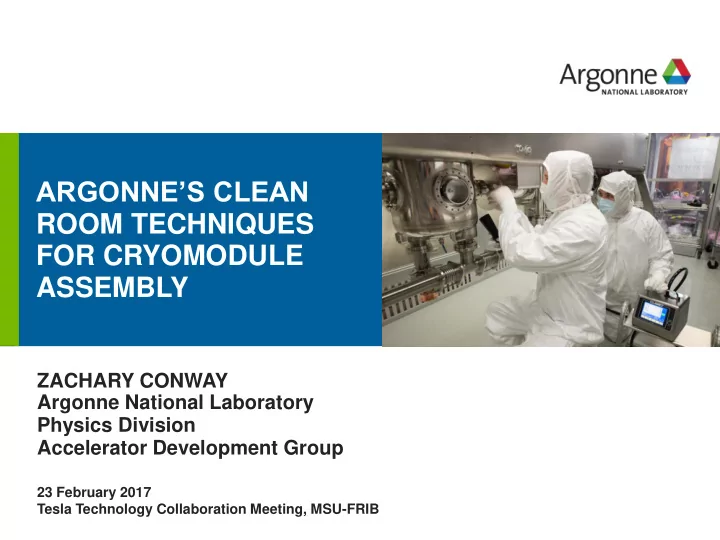

ARGONNE’S CLEAN ROOM TECHNIQUES FOR CRYOMODULE ASSEMBLY drhgfdjhngngfmhgmghmghjmghfmf ZACHARY CONWAY Argonne National Laboratory Physics Division Accelerator Development Group 23 February 2017 Tesla Technology Collaboration Meeting, MSU-FRIB
ARGONNE PERSONNEL WORKING ON THIS • Engineers: Senior Physicists: – M. Kedzie (PHY), – M.P. Kelly (PHY), and – T. Reid (HEP), – P.N. Ostroumov (PHY). – B. Guilfoyle (HEP), and Physicists: – W. Jansma (APS). – Z. Conway (PHY), and – S.-h. Kim (PHY). • Designers: – G. Cherry (NE). 2
OVERVIEW 72 MHz Quarter-Wave Resonator HPR Subcomponent cleaning. Cryomodule assembly. Vacuum pumping and venting. Installation in the beam line. Brief summary. Beam Line Cold Trap HPR Wand 3
SUBCOMPONENT CLEANING - I ANL Low- b EP Tool With QWR BCP/EP in the ANL/FNAL Joint Superconducting Cavity Surface Processing Facility. – Processing cavities for ANL, – FNAL, – BNL, and more. Hand tap all threaded holes. Collect all the parts you will need and have them ready. HWR 4
SUBCOMPONENT CLEANING - II HPR With Hand Held Nozzle HPR of Strong-Back Wipe/scrub: – Ethanol, – Acetone, – Dawn, – Alconox, and – Citrinox. Ultrasonic clean: – Alconox, 1-2% solution, or – Citronox, 1-2% soluition. QWR Beam Port HPR – 1-2 hours. – Final DI H2O ultrasonic cleaning. High pressure water rinse: – All parts are high pressure water rinsed. • ANL’s low - b HPR tool used for the cavities and solenoids. • Hand HPR of all parts and subcomponents. – As much of the assembly is done during the HPR as is practicable. – Focus on cleaning and reducing future work. 5
CLEAN ASSEMBLY Assembly as many parts as possible during the HPR . Things don’t get cleaner after this… The cavities and solenoids are sealed in the clean room after drying for ~48 hours and then transferred to the clean room where the beam line assembly is conducted. Typically the first parts are cleaned weeks before the final assembly. All ports to be connected during the final assembly are sealed with low- particulate covers/o-rings which can be removed smoothly. Keep a distance from all open ports during the work. – Operators do not make the clean room cleaner. – Special tooling may be required. 6
VACUUM PUMPING/VENTING FLOW CONTROL SYSTEM At Argonne the cryomodule pumping and venting is controlled by a pair of mass flow controllers: – One for evacuating the volume. – One for venting the volume. The flow rate is set to 50 mbar l/s. The vent gas is filtered with a 0.003 m m diffuser. The cryomodule pressure is held ~4 torr above atmosphere prior to opening the clean assembly. This system was used to replace all 7 pick-up probes on the 72 MHz QWR cryomodule operating in ATLAS since 2014 with no additional low- particulate cleaning. K. Zapfe , SRF’07 S. Gerbick , SRF’09 7
QWR PERFORMANCE AFTER 3 MONTHS ONLINE 10 W Replaced 1 beam-line gate valve and all 7 pick-up probes during cryomodule assembly. 8
Cold Trap With and Without the BEAM LINE INSTALLATION Vacuum Vessel Shown Clean cryomodules are installed next to non-clean accelerator hardware: – split-ring cavity cryomodules, – bunchers, and – e xperimental facilities/targets… etc. To mitigate the risk of dirty beam lines contaminating the clean cryomodules cold traps are installed on their inlet and outlet. Liquid nitrogen cooled 8” or 12” long, ϕ 1.3 ” ID, copper tubes provide a cold surface for freezing out water, oil, etc. All beam line connections are made in a temporary clean room set-up over the beam line. 9
SUMMARY Using many techniques developed by members from the TESLA collaboration. All parts are cleaned and high pressure water rinsed. After the HPR is finished we have a strong focus on reducing the amount of work/handling required for the final low-particulate assembly. Employ hardware to make sure the clean assembly stays clean: – Vacuum pumping/venting system to control and filter the flow. – Beam line cold traps to help reduce contamination from adjacent, dirty, accelerator components. Have employed these techniques on 2 cryomodules: 109 MHz QWR and a 72 MHz QWR. Working on a 162 MHz HWR cryomodule now. 10
Recommend
More recommend